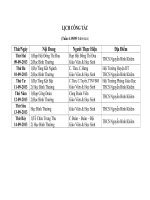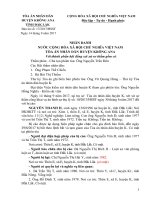14.09.2021 ver 2
Bạn đang xem bản rút gọn của tài liệu. Xem và tải ngay bản đầy đủ của tài liệu tại đây (129.18 KB, 9 trang )
ACTIVITY RATIO - EFFICIENCY RATIO
An activity ratio is a type of financial metric that indicates how efficiently a
company is leveraging the assets on its balance sheet, to generate revenues and
cash. Commonly referred to as efficiency ratios, activity ratios help analysts gauge
how a company handles inventory management, which is key to its operational
fluidity and overall fiscal health. (Will Kenton 2020)
Figure 2: The efficiency ratio chart shows the trends of Fixed Asset Turnover (FAT),
Account Payable Days (APP), Account Receivable Days (ACP), and Cash Conversion Cycle (CCC).
The fixed asset turnover ratio is a metric that measures how effectively a
company generates sales using its fixed assets. There's no ideal ratio that's
considered a benchmark for all industries. Instead, investors should compare a
company's fixed asset turnover ratio to those of other companies in the same sector.
(Laura Green, 2021)
Based on the chart, we can see that the company's fixed asset turnover in the
period 2016 - 2020 was relatively high, but it is lowest in 2016 with 1.39 rounds
and approximately industry fixed asset turnover is 1.29 due to the company
expanding production and increasing investment in production activities. In 2018,
fixed asset turnover in 2018 was 24.74 rounds per years higher many times than
the industry average, which is understandable given that the period of 2018 was a
period of growth. Economic growth, more affordable air travel, technological
change, new business models and visa facilitation have all contributed to the
growth of the international tourism industry over the years. recently.
In 2020, fixed asset turnover in 2020 higher many times than 2019 due to the
impact of the Covid epidemic, affecting the business activities of the company.
The cash conversion cycle (CCC) is a metric that expresses the time
(measured in days) it takes for a company to convert its investments in inventory
and other resources into cash flows from sales. Also called the Net Operating
Cycle or simply Cash Cycle, CCC attempts to measure how long each net input
dollar is tied up in the production and sales process before it gets converted into
cash received. (Adam Hayes, 2021)
Based on the data table, we can see that the Cash conversion cycle for the
period 2016 - 2020 is very high compared to the industry average. It is in the range
of 3 to 5 times the industry average.
In the period of 2017 - 2019, Cash conversion cycle of the company is still
at a safe level compared to the industry average, which proves that the company
has a decreasing or stable trend of Cash conversion cycle for many years, which is
a good sign. The sudden increase of Cash conversion cycle in 2020 proves that the
cash amount of businesses is increasingly scarce for production and business
activities and for other activities such as investment. Businesses need to balance in
the Cash conversion cycle to ensure the company's business operations.
Avg. A/R Days
2020
86.3
2019
47.1
2018
45.4
2017
40.7
2016
52.0
The receivables turnover ratio is an accounting measure used to quantify a
company's effectiveness in collecting its accounts receivable, or the money owed
by customers or clients. This ratio measures how well a company uses and
manages the credit it extends to customers and how quickly that short-term debt is
collected or is paid. (Chris B. Murphy, 2021)
In 2017, the reason for the decrease in average collection time was that in
2017 net sales decreased from $11,663 millions to $9,140 millions. The delay in
net sales was due to the implementation of the credit tightening policy in 2017
which made net sales decrease sharply. Because of the specifics of the company's
business, we can see that the average account receivable days is high compared to
other industries because the money collected from the service is calculated from
the time the customer makes a reservation until the customer checks out. That time
can be quite long. For the period 2018 - 2020, the company's receivable turnover
increased from 45.4 to 86.3 rounds. This tells me that at this stage the company is
loosening its trade credit policy, despite an increase in revenue. Based on the above
analysis, we can see that the company needs to adjust its credit policy to limit
capital misappropriation in business and investment activities.
2020
2019
2018
2017
2016
Avg. A/P Days
31.1
18.6
19.4
22.3
The accounts payable turnover ratio is a short-term liquidity measure used to
quantify the rate at which a company pays off its suppliers. Accounts payable
turnover shows how many times a company pays off its accounts payable during a
period. (Chris B. Murphy, 2020)
In 2016 average account payables days at 0 days, in 2017 this figure
increased to 22.3 days. The payables turnover ratio in 2018 and 2019 is smaller
than that of 2017 which proves that the enterprise is appropriating capital and
paying slower than the previous year. If the payables turnover ratio is too small
(large payables), there is a potential risk of liquidity. However, the company has
taken advantage of this capital appropriation, which can help the business reduce
capital costs, and at the same time demonstrate its reputation in terms of payment
relationship with suppliers and product quality for customers. This index improved
in 2020, partly due to the company increasing its liquidity and working capital in
2020 in response to the company's difficult situation.
DEBT RATIO - LEVERAGE RATIO
Debt/EBITDA - earnings before interest, taxes, depreciation, and
amortization - is a ratio measuring the amount of income generated and available
to pay down debt before covering interest, taxes, depreciation, and amortization
expenses. Debt/EBITDA measures a company's ability to pay off its incurred debt.
A high ratio result could indicate a company has a too-heavy debt load. (Will
Kenton 2020).
Hilton Inc have the (total Debt - Cash)/EBITDA ratio for the period 2016 –
2020 ranged from 3.61 to 27.89. The highest debt level fell in 2020 at 27.89
because the debt which use by Hilton is suddenlt increased to $18.245 million
compared to other years. This shows that Hilton Inc with this ratio much higher in
2020 than the industry average (more than 5 times) may indicate a company with
excessive debt burden. This can make the company's debt risk high, the company
needs to pay attention to the balance between debt and own capital.
The long-term debt to capitalization ratio, a variation of the traditional debtto-equity (D/E) ratio, shows the financial leverage of a firm. It is calculated by
dividing long-term debt by total available capital (long-term debt, preferred stock,
and common stock) (Adam Hayes, 2021)
The company's Long-term Debt to Total Capital ratio is increasing over the
years, much higher than the industry average of 50.4%. Overall, Long-term Debt
Total Capital increased year over year from 52.8% in 2016 to 115.9% in 2020. This
shows that the company to use its debt to carry out investment activities to expand
production and the company's debt is mainly long-term debt. The company's longterm debt is higher than that of its short - term debt.
MARKET RATIO
Figure: The market ratio chart indicates the trends of Price to Earnings
ratio by two main elements including stock price and earnings per share (EPS).
Source: />The price-to-earnings ratio (P/E ratio) is the ratio for valuing a company that
measures its current share price relative to its earnings per share (EPS). The priceto-earnings ratio is also sometimes known as the price multiple or the earnings
multiple. (Jason Fernando, 2021)
Earnings per share (EPS) is calculated as a company's profit divided by the
outstanding shares of its common stock. The resulting number serves as an
indicator of a company's profitability. It is common for a company to report EPS
that is adjusted for extraordinary items and potential share dilution. (Jason
Fernando, 2021)
According to above figure, the stock price of Hilton Inc. decreased from
$65.52 to $57.15 in the period 2016 to 2017 whereas it extended to strongly
increase in the period 2018 is $77.67 to $82.59 in 2019. However, EPS was
reported as negative from 2016 to 2029 which means Hilton was negative in
Retained Earnings (Accumulated Deficit) ). Since the negative EPS for that period,
the P/E ratio changed suddenly, peaking in 2017 with a value of 248.49. The
decrease in P/E index from 2018 - 2020 due to objective factors of the current
economic environment, affects the company's profit. The impact of the COVID-19
epidemic is also a factor affecting Hilton P/E ratio when the hotel business is
closed and temporarily closed, partly due to the low number of international
tourism.
REFERENCES
Adam Hayes 2021 ‘Cash Conversion Cycle (CCC)’ Investopedia 09 May
2021, < />Jason Fernando, 2021 ‘Price-to-Earnings (P/E) Ratio’ Investopedia 09
Septenber 2021, < />Jason Fernando, 2021 ‘Earnings Per Share (EPS)’ Investopedia 08 April
2021, < />Will Kenton, 2020 ‘Activity Ratios Definition’’ Investopedia 18 October
2020, < />Laura Green, 2021, ‘Fixed Asset Turnover Ratio’ Investopedia 09 August
2021,
< />
good-fixed-asset-turnover-ratio.asp>
Chris B. Murphy, 2021, ‘Receivables Turnover Ratio’ Investopedia 07 April
2021, < />Chris B. Murphy, 2020, ‘Receivables Turnover Ratio’ Investopedia 29 June
2020, < />Adam Hayes 2021 ‘Long-Term Debt to Capitalization Ratio’ Investopedia
09
July
2021,
< />
capitalization.asp>
Will Kenton, 2020 ‘Debt/EBITDA Ratio’ Investopedia 16 March 2020,
<h />
Corporate
Finance
Institute,
What
are
leverage
ratios?,
< />Macro Trends n.d., Hilton Worldwide Holdings PE Ratio 2006-2020 | HLT,
Macro Trends,< />Investing.com,
Hilton
Worldwide
Holdings
Inc
(HLT),
< />World Tourism Organization, International tourism growth continues to
outpace the global economy, 20 Jan 2020, < />EHotelier Editor, International tourism growth remains strong in 2018, 12
Oct 2018, < />Hilton Worldwide Holdings Inc, < />Nasdaq, Hilton Worldwide Holdings Inc. Common Stock (HLT),
< />









